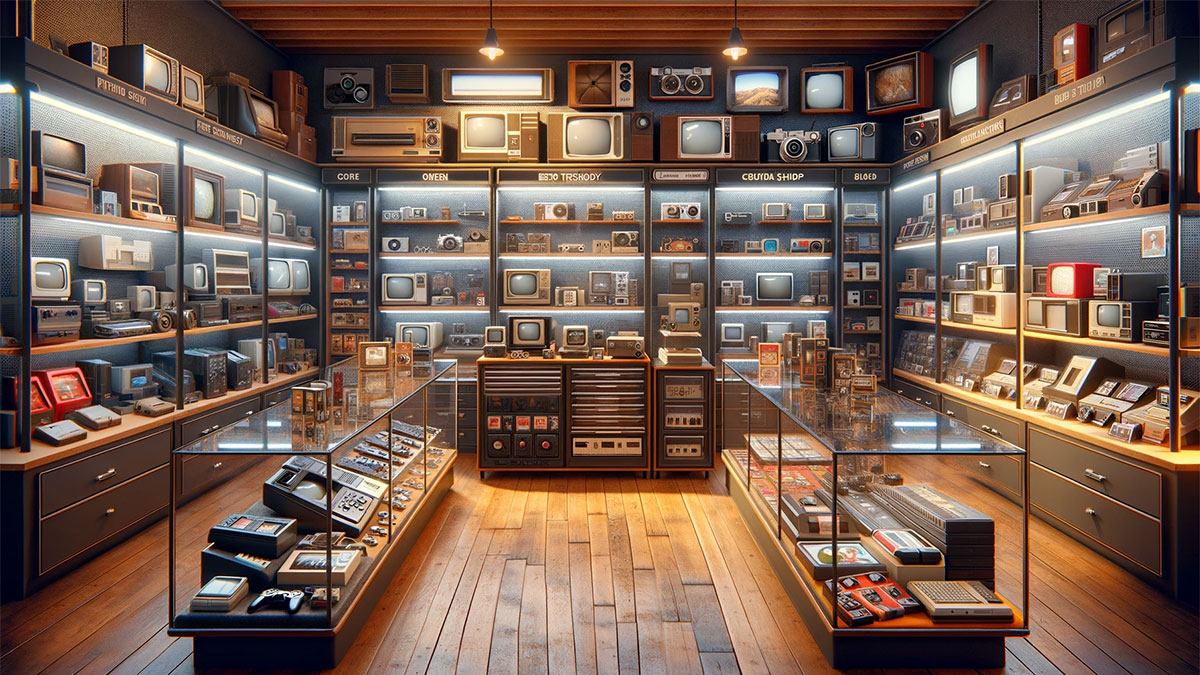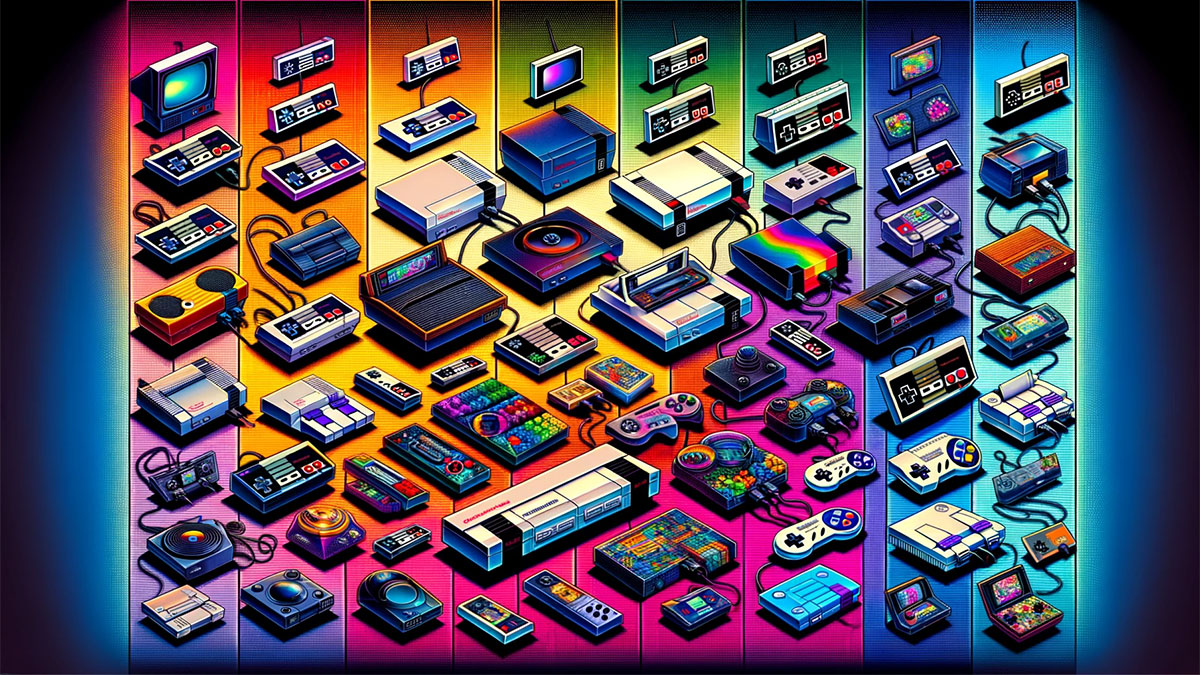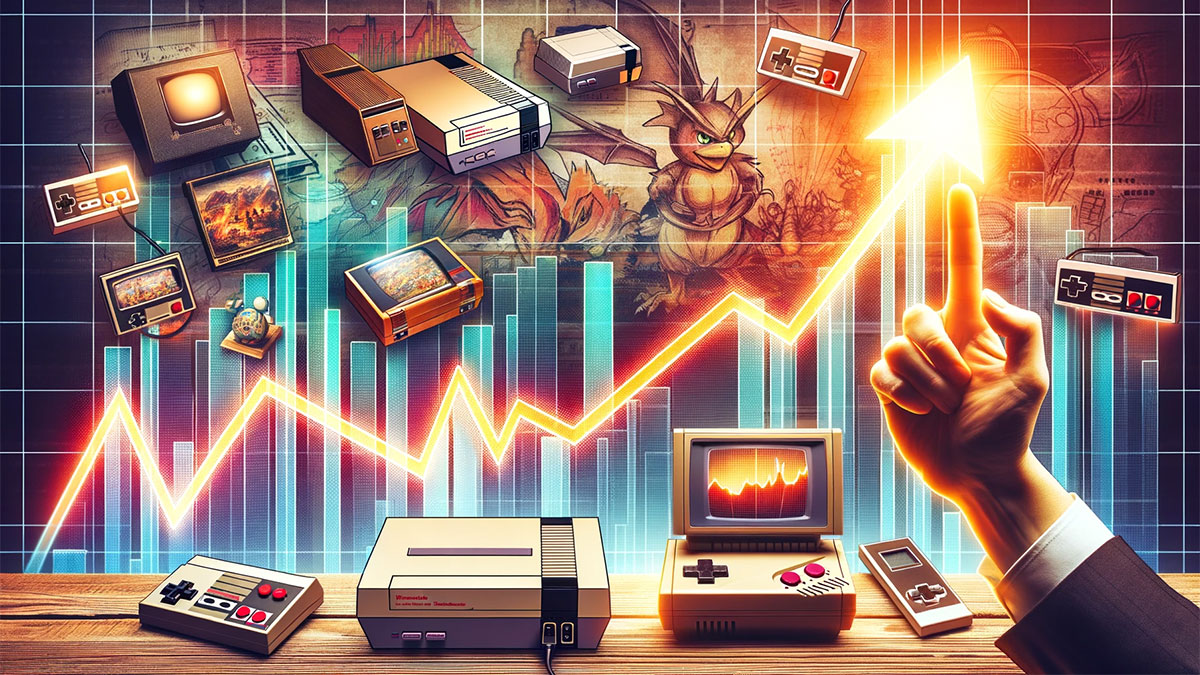Retro technology is making a comeback in modern times. From vinyl records to flip phones, people are embracing the nostalgia of the past. But what factors are contributing to this resurgence of retro technology?
One factor is the power of nostalgia. People often associate memories and emotions with certain objects or technologies from their past. By bringing back retro technology, companies tap into these emotions and create a sense of familiarity and comfort for consumers.
Another factor is the desire for simplicity and accessibility. Retro technology often has a straightforward design and is easy to use, which appeals to those who may feel overwhelmed by the complexity of modern technology. Additionally, retro technology can be more affordable than its modern counterparts, making it an attractive option for those on a budget.
Whatever the reason for its resurgence, each piece of retro-tech makes a comeback for its unique reasons. Usually only if it was highly popular to begin with and extremely well-made.
Key Takeaways
- A retro technology’s resurgence depends on its popularity in its time as well as the build quality.
- Retro technology’s simplicity and accessibility appeal to consumers is also paramount to a comeback.
- Retro technology can be more affordable than modern technology, making it attractive.
The Power of Nostalgia
Nostalgia is a powerful emotion that can evoke fond memories of the past. It is a feeling that many people experience when they think about older technology. The resurgence of retro technology can be attributed to the power of nostalgia.
The Appeal of Older Technology
One of the main reasons why people are drawn to older technology is the appeal of its simplicity. In a world where technology is constantly evolving, older technology can provide a sense of comfort and familiarity. People can often feel overwhelmed by the complexity of modern technology, and older technology can provide a sense of ease and simplicity.
Another appeal of older technology is its durability. Many older devices were built to last, and they can often outlast their modern counterparts. This durability can be appealing to people who are tired of constantly replacing their devices.
The Role of Advertising
Advertising also plays a significant role in the resurgence of retro technology. Companies are capitalizing on the nostalgia trend by reintroducing older products and designs. These products often have a modern twist, but they still evoke feelings of nostalgia.
Advertising can be a powerful tool for creating nostalgia. By using imagery and language that evokes memories of the past, companies can tap into people’s emotions and create a sense of longing for older technology.
The power of nostalgia is a significant factor in the resurgence of retro technology. The appeal of older technology and the role of advertising are two key factors that contribute to this trend. We will likely continue to see more retro technology in the future as people continue to seek out the comfort and familiarity of the past.
Retro Tech in Modern Times
Retro technology has been making a comeback in recent years, and it’s not hard to see why. With the rise of digital technology, people are starting to feel nostalgic for the analog products of the past. In this section, we will explore some of the factors that have contributed to the resurgence of retro technology in modern times.
Resurgence of Vinyl Sales
Vinyl records were once thought to be a thing of the past, but they have made a remarkable comeback in recent years. According to MRC data, vinyl sales made up just 1.7% of physical sales of music in 2011, but by 2021, they made up over 30% of physical sales. This resurgence can be attributed to the unique sound quality of vinyl, as well as the nostalgia factor. People are drawn to the physicality of vinyl records, and the experience of listening to an album from start to finish.
The Return of Polaroid
Polaroid cameras were once a staple of the photography world, but they fell out of favor with the rise of digital cameras. However, in recent years, Polaroid has made a comeback with the release of new instant cameras. These cameras allow users to take a photo and have a physical print in their hands within seconds. This instant gratification is a big draw for people who are tired of the endless scrolling through digital photos.
Flip Phones and Typewriters
Flip phones and typewriters are two other examples of retro technology that have made a comeback in recent years. Flip phones offer a respite from the constant notifications and distractions of smartphones, while typewriters offer a tactile experience that is missing from modern keyboards. Both of these products offer a sense of nostalgia and simplicity that people are drawn to in today’s fast-paced world.
The resurgence of retro technology can be attributed to a desire for physicality, simplicity, and nostalgia. As digital technology continues to dominate our lives, it’s no surprise that people are looking for ways to disconnect and experience the world in a more tactile way.
Technology and Innovation
Retro technology has seen a resurgence in recent years, and this can be attributed to a variety of factors. One of the main factors is the continuous evolution of technology and innovation. As new technologies emerge, people become more interested in the history of technology and how it has evolved. This has led to a renewed interest in retro technology.
Smartphones and Retro Tech
Smartphones have played a significant role in the resurgence of retro technology. The ability to access information and connect with others has made it easier for people to research and learn about older technologies. This has led to a renewed interest in retro technology and has even inspired some people to start collecting and using vintage tools and machines.
Innovative Uses of Retro Tools
In addition to the increased interest in retro technology, there has also been a growing trend of using retro tools and machines in innovative ways. Some artists and designers have started using old printing presses and typewriters to create unique and handmade designs. This has led to a renewed appreciation for the craftsmanship and quality of older technologies.
As technology continues to evolve, it will be interesting to see how retro technology continues to be used and appreciated in new and innovative ways.
The Processes and Techniques Behind Retro Tech
The Art of Retro Tech
Retro technology is not just about nostalgia for old gadgets and devices; it’s also about appreciating the art and design that went into creating them. The aesthetics of retro tech are often characterized by bold colors, geometric shapes, and futuristic designs that were popular in the 1960s and 1970s. These designs were often inspired by the space race and the optimism of the time.
One of the most iconic examples of retro tech design is the Apple Macintosh computer, which was released in 1984. The Macintosh was designed to be user-friendly and intuitive, with a graphical user interface that made it easy for anyone to use. The design of the Macintosh was heavily influenced by the work of Dieter Rams, a German industrial designer who was known for his minimalist designs.

The Manufacturing Process
The manufacturing process for retro tech was often more labor-intensive and time-consuming than modern manufacturing processes. Many retro gadgets and devices were made by hand, with skilled craftsmen using traditional techniques to create intricate designs and components.
Vinyl records were manufactured using a process called “pressing,” which involved creating a metal stamper from a master recording, and then using the stamper to press the vinyl into shape. This process required a high level of skill and precision, and it was not uncommon for records to be rejected if they did not meet the strict quality standards.
Similarly, retro gaming consoles like the Nintendo Entertainment System (NES) and the Sega Genesis were manufactured using a process called “through-hole technology,” which involved manually inserting components into circuit boards. This process was time-consuming and labor-intensive, but it allowed for a high level of customization and quality control.
The processes and techniques behind retro tech were often more artful and labor-intensive than modern manufacturing processes. This attention to detail and craftsmanship is one of the factors that contribute to the continued popularity of retro technology.
The Comeback of Retro Games
Retro gaming has seen a remarkable resurgence in recent years, capturing the hearts of both nostalgic older generations and curious new gamers. This phenomenon isn’t just a fleeting trend but a significant movement in the gaming industry, reflecting a deep-rooted appreciation for the classics and a simpler era of gaming.
The Lure of Nostalgia
One of the primary drivers behind the retro gaming resurgence is nostalgia. For many, retro games are a portal to their childhood or teenage years, evoking memories of simpler times. This emotional connection is powerful, enticing older gamers to revisit the games of their youth and share them with younger generations. The pixelated graphics, chiptune music, and straightforward gameplay of these games have a unique charm that modern high-definition games often lack.
Rediscovery by a New Generation
Interestingly, the allure of retro gaming extends beyond those who grew up with these games. Younger gamers, raised on a diet of high-definition graphics and complex gameplay, are discovering a new appreciation for the simplicity and directness of retro games.
This rediscovery is fueled by the availability of retro games on modern platforms, including online emulators, remastered versions, and dedicated retro gaming consoles.
The Role of Technology and Accessibility
Advancements in technology have played a significant role in the resurgence of retro gaming. Emulators, digital downloads, and dedicated retro consoles like the NES Classic Edition make it easier than ever for gamers to access classic titles.
Online marketplaces and platforms like Steam and the Nintendo eShop have dedicated sections for retro games, indicating a strong market demand.
Cultural Impact and Community
The retro gaming resurgence has also been propelled by a robust community of enthusiasts who organize events, share content, and create modifications for classic games. Social media, gaming forums, and platforms like Twitch and YouTube have become hotspots for retro gaming content, fostering a sense of community and belonging among fans.
All this in addition to a flurry of retro gaming blogs and websites that have popped up with tons of great content. Retro gaming conventions and competitions have also become increasingly popular, celebrating the history and culture of video gaming.
The Future of Retro Gaming
The future of retro gaming looks promising as it continues to evolve. With the emergence of VR and AR technologies, there’s potential for a new dimension in retro gaming – perhaps revisiting classic titles in immersive environments.
The industry’s recognition of the value of retro games ensures that they will continue to be preserved and celebrated, not just as relics of the past but as timeless pieces of entertainment.
Retro Tech in Various Sectors
Retro technology has made a comeback in various sectors, including transport, communications, exploration, and information processing. In these sectors, retro technology has been used to enhance efficiency, reduce costs, and provide a more personalized experience to users.
Transport and Communications
Retro technology has been used in the transport and communications sectors to provide a more personalized experience to users. Vintage cars have become popular again in recent years due to their unique designs and nostalgic appeal. Similarly, vintage bicycles have also seen a resurgence in popularity due to their classic designs and durability.
In the communications sector, retro technology has been used to provide a more tactile experience to users. Rotary phones have become popular again due to their satisfying clicking sound and the physical sensation of dialing a number.
Similarly, retro-style televisions have also become popular due to their unique designs and the nostalgic appeal of watching shows on a vintage TV set.
Exploration and Information Processing
Retro technology has also been used in the exploration and information processing sectors to enhance efficiency and reduce costs. Vintage cameras have become popular again in recent years due to their simplicity and durability. Similarly, retro-style typewriters have also seen a resurgence in popularity due to their tactile feedback and the nostalgia of typing on a vintage machine.
In the information processing sector, retro technology has been used to enhance security and privacy. Some users have started using vintage computers and operating systems to protect their data from modern cyber threats. Similarly, vintage calculators and other electronic devices have also seen a resurgence in popularity due to their simplicity and durability.
Retro tech has made a comeback in various sectors due to its unique designs, tactile feedback, and nostalgic appeal. As technology continues to evolve, it will be interesting to see how retro technology continues to shape and influence the modern world.
Impact on the Market
The resurgence of retro technology has had a significant impact on the market. The following subsections discuss the impact of retro tech on capital and materials and production.
Retro Tech and Capital
The popularity of retro technology has led to an increase in demand for old-school gadgets. This has created a new market for retro tech, which has attracted investors and entrepreneurs. The growth of this market has led to an increase in capital investment, which has helped to fund the development of new retro tech products.
Materials and Production
The resurgence of retro technology has also had an impact on materials and production. Many retro tech products are made using materials that are no longer widely available. This has led to an increase in demand for these materials, which has driven up their prices. As a result, manufacturers of retro tech products have had to find new sources of materials or develop new production methods to keep costs down.
In addition, the production of retro tech products often requires specialized knowledge and skills that are no longer widely available. This has led to the development of new training programs and apprenticeships to help train a new generation of retro tech experts.
Retro technology has had a significant impact on the market, driving up demand for old-school gadgets and creating many new opportunities for all types of entrepreneurs and investors. At the same time, it has also posed challenges for manufacturers, who must find new ways to source materials and develop new production methods to keep costs down.
Case Study: Casio and Vinyl Record
Casio, a Japanese multinational consumer electronics company, is known for its innovative products that blend advanced technology with retro design. The company’s recent foray into vinyl record players is a prime example of this approach.
Casio’s vinyl record player, released in 2021, has been a hit among music lovers who appreciate the warm, authentic sound of vinyl. The turntable is designed to look like a classic record player from the 1970s, complete with a wooden base and a dust cover. The turntable is also equipped with modern features such as Bluetooth connectivity, a built-in phono preamp, and a USB port for digitizing vinyl records.
The success of Casio’s vinyl record player can be attributed to several factors. Firstly, the resurgence of vinyl records in recent years has created a growing market for retro technology. Vinyl records offer a tangible, tactile listening experience that cannot be replicated by digital formats. Secondly, Casio’s turntable appeals to consumers who value both style and substance. The turntable’s vintage design is eye-catching and nostalgic, but it also delivers high-quality sound and modern convenience.
Casio’s vinyl record player is a prime example of how retro technology can be reinvented for modern consumers. By combining vintage design with advanced features, Casio has tapped into a growing market for retro technology and created a product that appeals to both audiophiles and design enthusiasts.



